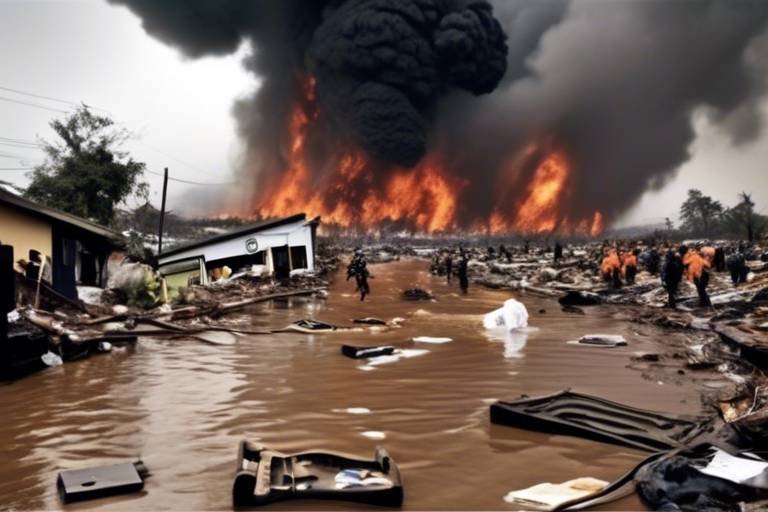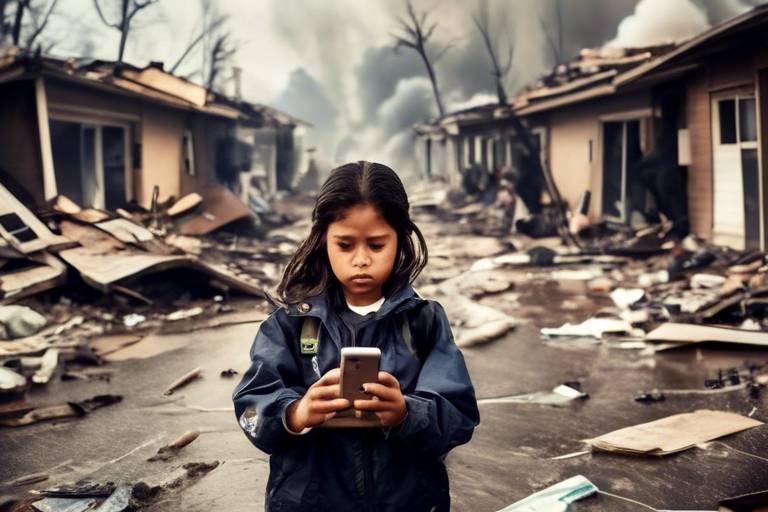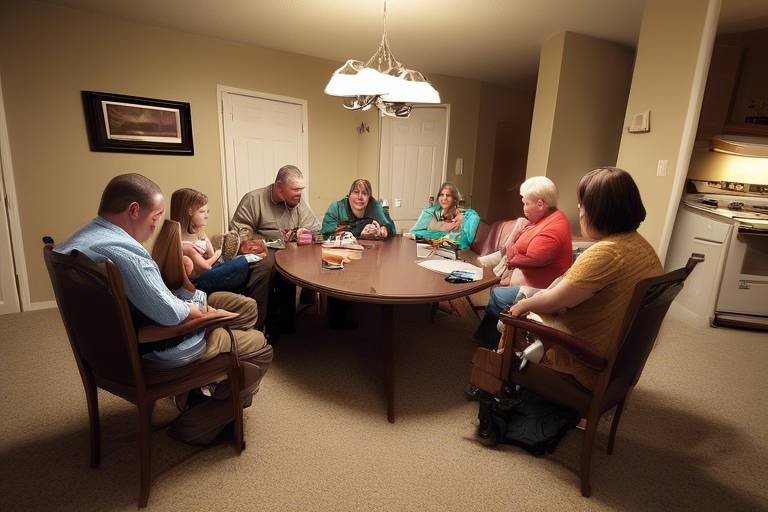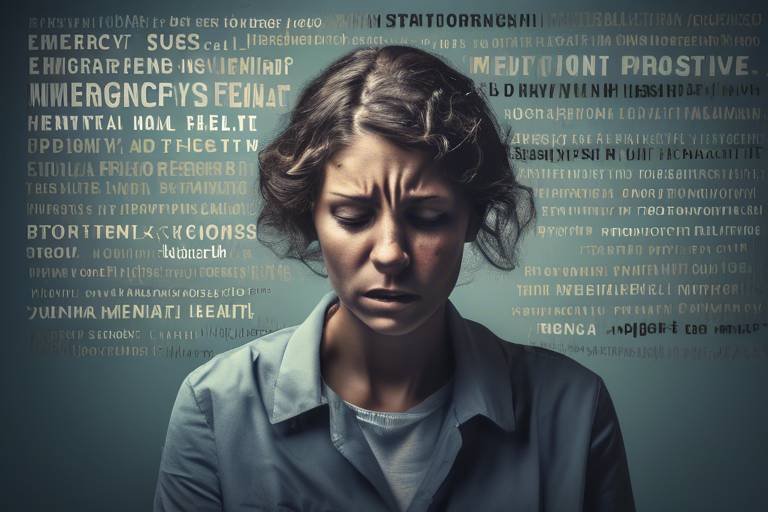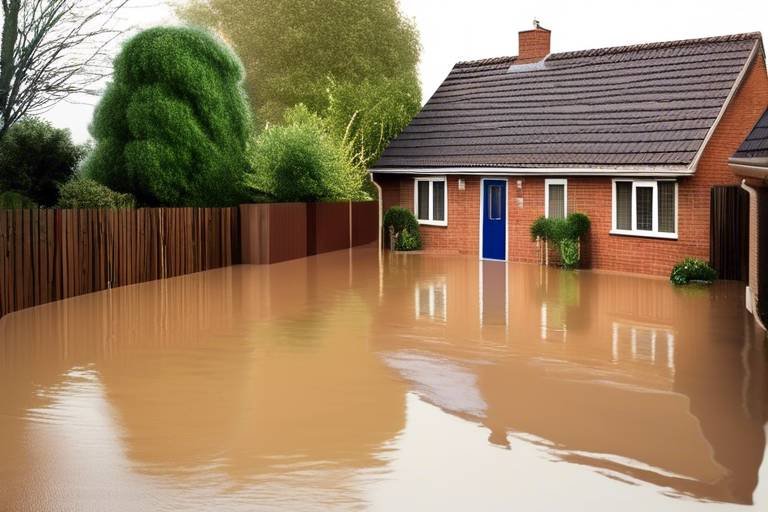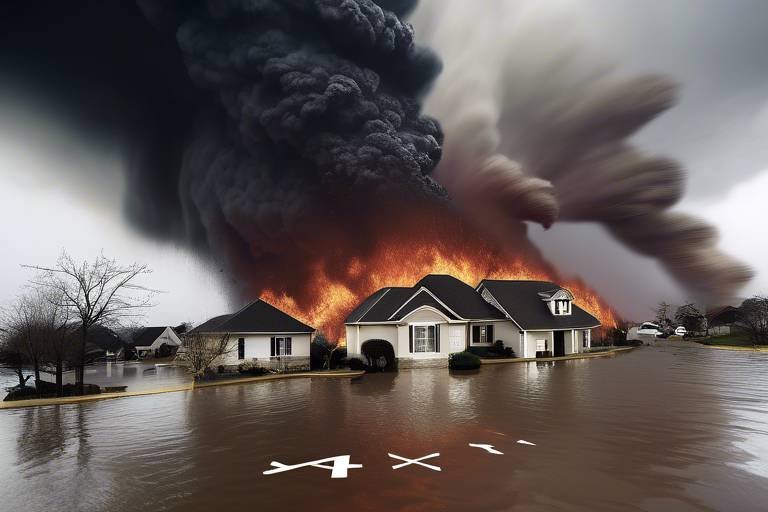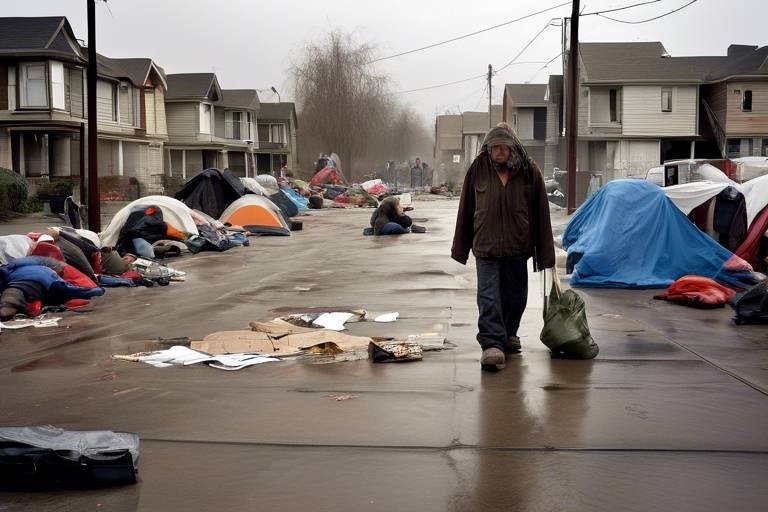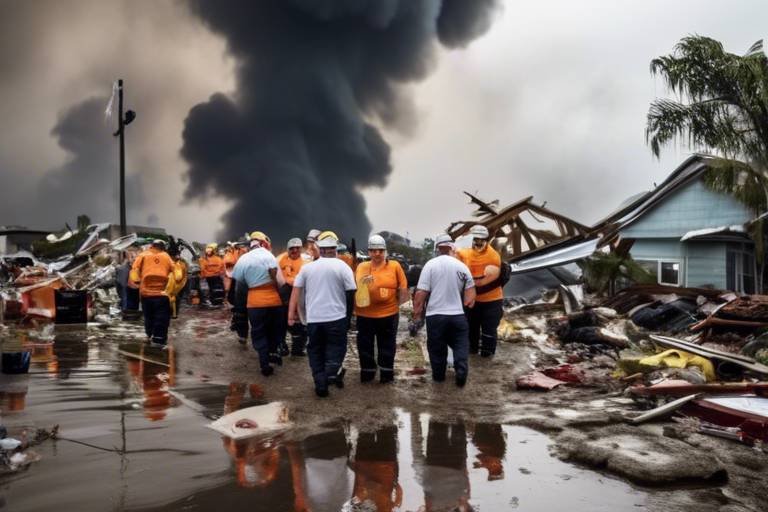The Role of the Media in Disaster Reporting
In the chaotic aftermath of a disaster, when the world seems to spin out of control, the media emerges as a beacon of hope and information. This article explores the critical function of media during disasters, examining how it informs the public, shapes narratives, and influences response efforts in times of crisis. Whether it's a natural calamity like a hurricane or a man-made disaster, the media's role is pivotal in ensuring that people receive timely and accurate information. Imagine being in a situation where every second counts; the media can mean the difference between life and death.
When disaster strikes, timely information is vital. It acts like a lifeline, guiding individuals on what steps to take next. Quick reporting can save lives and aid in effective response strategies. For instance, consider a scenario where a flood is imminent. The media's rapid dissemination of alerts can prompt evacuations, allowing people to escape danger. This section discusses how the media acts as a conduit for crucial updates, delivering information on evacuation routes, emergency services, and safety protocols. In a world where misinformation can spread like wildfire, the media's responsibility to provide accurate, timely updates is more important than ever.
However, with great power comes great responsibility. Ethics play a significant role in disaster reporting. Journalists are tasked with the delicate balance of reporting accurately while maintaining sensitivity to the victims and their families. The need for information must be balanced with respect for those affected. This section delves into the responsibilities of journalists, highlighting how they must navigate the fine line between informing the public and respecting the dignity of individuals in distress.
Journalists face numerous challenges when reporting on disasters. Maintaining objectivity while covering traumatic events can be incredibly difficult. Imagine trying to capture the essence of a tragedy while also ensuring that your words do not further traumatize those involved. The impact on public perception can be significant; sensationalized reporting can lead to fear and panic, while accurate reporting can foster understanding and resilience. This subsection highlights these challenges and the ethical dilemmas journalists often encounter.
Striking a balance between engaging storytelling and respectful reporting is crucial. How can media outlets captivate audiences without crossing the line into sensationalism? This section examines the techniques that journalists can employ to avoid sensationalism while still delivering impactful narratives. By focusing on human stories and the broader implications of a disaster, the media can engage audiences without resorting to shock tactics that may exploit the suffering of others.
In the fast-paced world of disaster reporting, fact-checking becomes even more critical. Misinformation can spread rapidly, leading to confusion and panic among the public. This part discusses the importance of verifying information before dissemination. Journalists must be vigilant, ensuring that every piece of information they share is accurate and reliable. In an age where social media can amplify false narratives, the responsibility of traditional media to act as a reliable source has never been more pronounced.
Social media has transformed disaster reporting in ways we couldn't have imagined just a decade ago. Platforms like Twitter and Facebook serve as real-time information sources, allowing individuals to share updates and seek help. However, this democratization of information also poses challenges regarding the spread of misinformation. This section explores how social media can be both a blessing and a curse in disaster scenarios, emphasizing the need for critical thinking among users.
Local and national media play different yet complementary roles in disaster coverage. Local outlets provide community-specific information, while national media offers broader context and resources. This part investigates how these two types of media work together to ensure that the public is informed and prepared during crises.
Local media often engage directly with communities during disasters. They are on the ground, reporting from the heart of the affected areas. This subsection highlights how local journalists foster connections and provide tailored information that addresses the unique needs of affected populations. By focusing on local stories and voices, they create a narrative that resonates with the community, fostering a sense of solidarity and support.
On the other hand, national media provide a wider lens on disasters. They contribute to national awareness and policy discussions, influencing government response and resource allocation during crises. This section discusses how national media can bring attention to issues that may otherwise go unnoticed, ensuring that the needs of affected communities are addressed at all levels of government.
- What is the role of media during a disaster? The media provides timely information, informs the public about safety measures, and shapes narratives that can influence response efforts.
- How do journalists maintain ethics in disaster reporting? Journalists must balance the need for information with sensitivity towards victims, ensuring accurate reporting without sensationalism.
- What challenges do journalists face in disaster reporting? They often struggle with maintaining objectivity, dealing with emotional content, and combating misinformation.
- How has social media changed disaster reporting? Social media allows for real-time updates and engagement but also increases the risk of misinformation spreading quickly.

The Importance of Timely Information
This article explores the critical function of media during disasters, examining how it informs the public, shapes narratives, and influences response efforts in times of crisis.
When disaster strikes, the clock starts ticking, and timely information becomes a lifeline for those affected. Imagine being in the middle of a natural disaster—your heart racing, uncertainty looming, and the only thing you crave is clarity. This is where the media steps in, acting as a bridge between chaos and calm. Quick reporting can literally save lives; it enables individuals to make informed decisions about their safety and well-being. For instance, during hurricanes, timely updates on evacuation routes, shelter availability, and weather conditions can mean the difference between life and death.
The media's role in disseminating crucial updates cannot be overstated. In many cases, traditional news outlets, alongside social media platforms, become the primary source of information. They provide updates on emergency services, health advisories, and community resources. A well-structured response can be achieved when the public is equipped with accurate information. Let's break down some key aspects of why timely information is essential:
- Life-Saving Decisions: Rapid updates help individuals and families make crucial choices about evacuation and safety.
- Resource Allocation: Emergency services rely on accurate information to deploy resources effectively, ensuring that help reaches those in need promptly.
- Community Coordination: Local media can facilitate communication among community members, helping them to support one another during crises.
Moreover, the immediacy of information in today's digital age amplifies its importance. Social media platforms like Twitter and Facebook allow for real-time updates, enabling citizens to stay informed even when traditional media may be delayed. However, this rapid dissemination can also lead to the spread of misinformation, which is why the media must prioritize accuracy alongside speed. The challenge lies in ensuring that the information shared is not only timely but also reliable, as the repercussions of misinformation can be dire.
Consider the aftermath of major disasters like Hurricane Katrina or the 9/11 attacks. In these instances, the media played a pivotal role in shaping public perception and government response. The stories that emerged from these events were not just about statistics; they were about real people facing unimaginable challenges. When the media reports swiftly and accurately, it not only informs the public but also holds authorities accountable for their actions, influencing policy and resource allocation in the wake of a disaster.
In conclusion, the importance of timely information during disasters cannot be emphasized enough. The media serves as a crucial lifeline, providing updates that enable individuals to make informed decisions, facilitating resource allocation, and fostering community coordination. As we move forward in an increasingly interconnected world, the responsibility of the media to deliver accurate and timely information becomes even more significant.
Q: Why is timely information crucial during a disaster?
A: Timely information is vital as it helps individuals make informed decisions about their safety, enables emergency services to allocate resources effectively, and fosters community support.
Q: How does social media influence disaster reporting?
A: Social media provides real-time updates and allows for rapid information sharing, but it can also lead to the spread of misinformation, making accuracy essential.
Q: What role do local media play in disaster situations?
A: Local media provide community-specific information and engage directly with residents to address their unique needs during disasters.

When disaster strikes, the media becomes a lifeline, a beacon of hope, and sometimes, unfortunately, a source of distress. The ethics of reporting during such critical times is not just a guideline; it's a moral compass that helps journalists navigate the turbulent waters of tragedy and chaos. Journalists hold the power to shape narratives, influence public perception, and ultimately impact the effectiveness of response efforts. Therefore, their responsibilities are immense. They must report not just with speed, but with a profound sense of respect for the victims and their families. This balance is crucial, as the stories told can either uplift communities or exacerbate their suffering.
In the chaos of a disaster, the urgency to provide timely updates can lead to a rush in reporting. However, accuracy should never be sacrificed for the sake of speed. Ethical reporting means verifying facts before broadcasting them to the world. This is where the mantra of "first, do no harm" comes into play. Journalists must ask themselves: Are we informing the public, or are we merely sensationalizing tragedy for ratings? This ethical dilemma is at the heart of responsible journalism.
Moreover, the emotional toll on victims and their families cannot be overstated. Reporters often find themselves in situations where they must approach grieving individuals or communities. This requires a delicate balance of empathy and professionalism. It’s essential to remember that behind every statistic or headline, there’s a human story filled with pain and loss. Ethical journalists strive to tell these stories with dignity, ensuring that the voices of the affected are heard without exploiting their suffering.
To further illustrate the significance of ethics in disaster reporting, consider the following key principles:
- Accuracy: Ensure all information is verified and correct before dissemination.
- Respect: Honor the dignity of victims and their families by reporting sensitively.
- Objectivity: Maintain neutrality, avoiding bias that could skew public perception.
- Accountability: Acknowledge mistakes and correct them promptly to maintain trust.
In essence, the role of ethics in disaster reporting is not merely an academic concern; it is a practical necessity. By adhering to these principles, journalists can foster trust and credibility, which are invaluable in times of crisis. This trust is what allows the media to serve its purpose effectively: to inform, to educate, and to empower the public. As we navigate through the complexities of disaster reporting, let us remember that our words have power, and with that power comes the responsibility to wield it wisely.

When it comes to reporting on disasters, journalists find themselves walking a tightrope between delivering vital information and maintaining a sense of ethics and responsibility. The challenges they face are numerous and complex, often requiring them to make quick decisions that can significantly impact public perception and the lives of those affected. For instance, how do reporters balance the urgency of disseminating information with the need to respect the privacy and dignity of victims and their families?
One of the primary challenges is the emotional toll that covering disasters can take on journalists themselves. They are often exposed to traumatic scenes and stories, which can lead to moral dilemmas about how to portray these events. Should they focus on the human suffering involved, or should they highlight the efforts of first responders and community resilience? This dilemma can create a conflict between objectivity and empathy, making it difficult to strike the right tone in their reporting.
Moreover, the pressure to be the first to break a story can lead to the dissemination of inaccurate information. In the heat of the moment, journalists may prioritize speed over accuracy, which can exacerbate the chaos surrounding a disaster. This urgency is compounded by the rise of social media, where unverified information can spread like wildfire, further complicating the journalist's role in maintaining truth and clarity.
Additionally, journalists must navigate the tricky waters of sensationalism. In an effort to capture audience attention, some media outlets may resort to exaggerated headlines or graphic imagery that can overshadow the real stories of resilience and recovery. This not only distorts public perception but can also lead to desensitization among audiences, making them less responsive to future crises.
To illustrate these challenges, consider the following key points:
- Emotional Impact: Reporters often grapple with their own feelings while covering traumatic events.
- Pressure for Speed: The race to report first can compromise the accuracy of information.
- Sensationalism vs. Sensitivity: Balancing engaging storytelling with respectful reporting is crucial.
In summary, ethical reporting during disasters is fraught with challenges that require journalists to constantly evaluate their practices. They must strive to inform the public while also honoring the dignity of those affected by the events they cover. This balance is not just a professional responsibility but a moral imperative that can shape the very fabric of community resilience and recovery.
- What is the role of media during a disaster? The media plays a crucial role in informing the public, shaping narratives, and influencing response efforts during disasters.
- How can journalists maintain ethical standards in disaster reporting? Journalists can maintain ethical standards by prioritizing accuracy, being sensitive to victims, and avoiding sensationalism.
- What challenges do journalists face when reporting on disasters? Journalists face challenges such as emotional impact, pressure for speed, and the risk of sensationalism.

In the chaotic aftermath of a disaster, the media finds itself at a crossroads, where the paths of sensation and sensitivity diverge. On one hand, there is an undeniable urge to captivate audiences with gripping stories and shocking visuals that highlight the gravity of the situation. On the other hand, there lies the profound responsibility to honor the experiences of those affected, ensuring that their narratives are treated with the utmost care and respect. This delicate balance can often feel like walking a tightrope, where a misstep in either direction can lead to significant consequences.
Consider this: when a natural disaster strikes, viewers are often glued to their screens, hungry for updates. The media's role becomes crucial, as they strive to inform the public about the evolving situation. However, in their quest to deliver breaking news, some outlets may inadvertently cross the line into sensationalism, prioritizing shock value over the dignity of victims. For instance, broadcasting graphic images or overly dramatized accounts can create a spectacle that diminishes the real pain and suffering endured by individuals and communities.
To navigate this challenging landscape, journalists and media outlets must adhere to a few guiding principles:
- Empathy: Understanding the emotional toll on victims and their families is paramount. Reporters should strive to convey stories that reflect the humanity of those impacted rather than reducing them to mere statistics.
- Context: Providing background information helps audiences grasp the full scope of the disaster. Instead of sensational headlines, offering a well-rounded narrative fosters a deeper understanding of the event's implications.
- Respect: Always prioritize the privacy and dignity of victims. This means asking for consent before sharing personal stories or images, and being sensitive to the timing of such disclosures.
By focusing on these principles, media can create a narrative that is not only engaging but also responsible. It’s about telling the story without losing sight of the people at its heart. For instance, rather than sensationalizing a tragic event, a journalist might choose to highlight the community's resilience and recovery efforts, showcasing how individuals come together in times of crisis.
Ultimately, the goal of disaster reporting should be to inform, educate, and inspire action, rather than to shock or exploit. The media has the power to shape public perception and influence response efforts, and with that power comes an immense responsibility. By prioritizing sensitivity over sensationalism, journalists can help foster a more compassionate understanding of the challenges faced by those affected by disasters.
- What is the role of the media during disasters?
The media serves to inform the public, provide updates, and shape narratives that can influence response efforts and community resilience. - How can media avoid sensationalism in reporting?
By adhering to principles of empathy, context, and respect, journalists can focus on responsible storytelling that honors the experiences of victims. - Why is timely information important in disaster scenarios?
Timely information can save lives by ensuring that individuals have access to crucial updates and resources during a crisis.

When disaster strikes, the chaos and confusion can be overwhelming, not just for those directly affected but also for the media trying to report on the situation. In these high-stakes moments, fact-checking becomes a critical lifeline. The urgency to disseminate information can lead to the spread of rumors and inaccuracies, which can exacerbate the already tense environment. Therefore, it is essential for journalists and media outlets to prioritize accuracy over speed to maintain public trust and ensure safety.
Imagine a scenario where a natural disaster has just occurred. News outlets rush to report on the event, but without proper verification, they might broadcast unconfirmed information. This can lead to panic, misallocation of resources, and even hinder rescue efforts. For instance, if a report falsely claims that a certain area is safe when it is not, individuals may put themselves in harm's way, believing they are out of danger. This is precisely why fact-checking is not just a journalistic responsibility; it is a moral imperative.
In the age of digital media, the challenge of fact-checking has become even more pronounced. Social media platforms are flooded with posts and updates, many of which lack verification. Journalists must navigate this landscape carefully, distinguishing between credible sources and misinformation. To assist in this process, many media organizations have adopted specific strategies for fact-checking during crises:
- Utilizing Trusted Sources: Relying on official announcements from government agencies, emergency services, and reputable organizations.
- Cross-Referencing Information: Checking multiple sources to confirm the validity of a report before sharing it with the public.
- Engaging with Experts: Consulting with professionals who have firsthand knowledge of the situation can provide clarity and context.
Moreover, the role of technology in fact-checking cannot be overstated. Tools and platforms that specialize in verifying information can significantly aid journalists. For example, websites dedicated to debunking misinformation can quickly provide updates on what is accurate and what is not. Additionally, media outlets can leverage their own platforms to educate the public on how to identify reliable information sources. This not only helps in the immediate crisis but also empowers individuals for future situations.
In conclusion, fact-checking in crisis situations is a vital component of responsible journalism. It requires a delicate balance of urgency and diligence, ensuring that the information shared is both timely and accurate. By prioritizing fact-checking, media outlets can play a pivotal role in guiding the public through the fog of disaster, helping to mitigate panic and ensure that communities receive the help they need.
- Why is fact-checking so important during disasters?
Fact-checking ensures that the information being reported is accurate, which can save lives and help manage public response effectively. - How can I identify reliable information during a crisis?
Look for updates from official sources, cross-check information with multiple outlets, and be cautious of sensational headlines. - What role does social media play in disaster reporting?
Social media can spread information quickly but also contributes to the spread of misinformation, making it essential for users to verify what they read.

In today's fast-paced digital world, social media has revolutionized the way we consume news, especially during disasters. Platforms like Twitter, Facebook, and Instagram have become vital sources of real-time information, allowing individuals to share updates, images, and videos almost instantaneously. This immediate access to information can be a double-edged sword; while it facilitates rapid dissemination, it also raises concerns about misinformation and the need for verification.
One of the most significant advantages of social media during disasters is its ability to connect people. Imagine being in the middle of a natural disaster, and you can instantly see updates from friends, family, and local authorities. This connectivity not only provides critical information but also helps to reassure individuals that they are not alone in their struggles. However, the speed at which information spreads can lead to confusion and panic if false reports go viral. For instance, during Hurricane Harvey, social media was flooded with posts, some of which contained inaccurate information that hindered rescue efforts.
Moreover, social media serves as a platform for community engagement. Local organizations and government agencies can utilize these platforms to communicate effectively with residents, providing essential information such as evacuation routes, shelter locations, and safety tips. This direct line of communication can significantly enhance the efficacy of response efforts. However, it also places a burden on these entities to ensure that the information they share is accurate and timely.
To illustrate the impact of social media on disaster reporting, consider the following table that outlines both the benefits and challenges:
| Benefits | Challenges |
|---|---|
| Real-time updates | Spread of misinformation |
| Community engagement | Difficulty in verifying sources |
| Wider reach | Overwhelming volume of information |
| Emotional support | Privacy concerns |
In conclusion, while social media is a powerful tool for disaster reporting, it is crucial for users to approach the information they encounter with a critical eye. Always consider the source and verify facts before sharing. As we continue to navigate the complexities of disaster reporting in the digital age, the role of social media will undoubtedly evolve, shaping how we respond to crises in unprecedented ways.
- How does social media help during disasters? Social media provides real-time updates, connects communities, and allows for the rapid dissemination of crucial information.
- What are the risks associated with social media during disasters? The primary risks include the spread of misinformation, difficulty in verifying sources, and overwhelming amounts of information that may confuse the public.
- How can I ensure the information I receive on social media is accurate? Always check the credibility of the source, look for corroborating reports from trusted news outlets, and be cautious about sharing unverified information.

When disaster strikes, the media landscape becomes a vital battleground for information. Local and national media serve different, yet complementary roles in disaster reporting, each essential in its own right. Local media outlets often have a closer connection to the communities they serve, allowing them to provide immediate, relevant information tailored to the specific needs of affected populations. Imagine a small-town radio station broadcasting updates during a hurricane; they know their audience intimately, and their reports can be lifesaving, offering localized advice on evacuation routes or shelter locations.
On the other hand, national media plays a crucial role in framing the broader context of the disaster. They provide a macro perspective, highlighting not just the immediate impacts but also the systemic issues that may have contributed to the crisis. For instance, during a wildfire, national news outlets might delve into discussions about climate change, forest management policies, and government preparedness, prompting conversations that extend far beyond the flames. This broader narrative can influence policy discussions and resource allocation, making national coverage a key player in disaster management and recovery efforts.
Moreover, the interplay between local and national media is fascinating. Local journalists often rely on national outlets for broader context, while national media depend on local reporters for on-the-ground insights. This relationship can be likened to a well-tuned orchestra, where each musician plays their part to create a harmonious symphony of information. However, this collaboration is not without its challenges. Local media may feel overshadowed by national coverage, especially when major networks swoop in during high-profile disasters, potentially sidelining community voices.
In times of crisis, the most effective disaster reporting often comes from a blend of local and national efforts. Local media can provide timely updates and community-specific information, while national outlets can amplify these stories, ensuring they reach a wider audience. This synergy not only informs the public but also fosters a sense of solidarity and shared experience among those affected by the disaster.
In conclusion, while local and national media have distinct roles in disaster reporting, they are both indispensable. Their collaborative efforts can enhance public understanding and response, ultimately making communities more resilient in the face of adversity. As we navigate this complex landscape of information, it is crucial to recognize and appreciate the unique contributions of each media type in shaping our understanding of disasters and their aftermath.
- What is the main difference between local and national media in disaster reporting?
Local media focuses on community-specific information, while national media provides broader context and systemic analysis. - How do local media outlets help during disasters?
They offer timely updates, tailored information, and foster community engagement, ensuring that residents receive relevant advice and support. - Why is national media important in disaster situations?
National media can influence policy discussions, raise awareness about systemic issues, and ensure that the stories of affected communities reach a larger audience.

When disaster strikes, local media becomes the heartbeat of the community, serving as a vital link between those affected and the resources they need. Think of local journalists as the neighborhood watch, but instead of keeping an eye out for crime, they are on the front lines, reporting real-time updates that can make a world of difference. They know the streets, the people, and the unique challenges that their audience faces, which allows them to provide tailored information that resonates deeply with the community.
Local media outlets often engage with their audience through various platforms, ensuring that crucial information reaches those who need it most. From radio broadcasts to social media posts, local journalists are adept at using multiple channels to disseminate information quickly. They often hold community forums, either virtually or in-person, where residents can ask questions and receive immediate answers. This two-way communication fosters a sense of trust and solidarity, making residents feel heard and valued during times of crisis.
Moreover, local media plays a critical role in amplifying the voices of those who might otherwise go unheard. For instance, they often highlight stories of local heroes—like firefighters, volunteers, or even everyday citizens who step up to help their neighbors. By sharing these narratives, local outlets not only inform the public but also inspire hope and resilience within the community.
In addition to reporting on immediate needs, local media also focuses on recovery efforts post-disaster. They provide information on rebuilding resources, mental health support, and community meetings that facilitate recovery. This ongoing engagement helps to maintain community cohesion and encourages residents to come together to support one another, reinforcing the idea that they are not alone in their struggles.
To illustrate how local media engages with their communities during disasters, consider the following table that outlines key activities they undertake:
| Activity | Description |
|---|---|
| Real-Time Updates | Providing immediate information on evacuation routes, safety measures, and emergency services. |
| Community Forums | Hosting discussions where residents can ask questions and share concerns directly with journalists. |
| Highlighting Local Heroes | Sharing stories of individuals making a difference, fostering community pride and resilience. |
| Post-Disaster Recovery Resources | Informing the public about rebuilding efforts, mental health resources, and community support initiatives. |
In conclusion, the role of local media in disaster situations cannot be overstated. They are more than just reporters; they are community advocates, providing essential information and support that can significantly impact the lives of those affected. By engaging with their audience and fostering a sense of community, local media not only informs but also empowers citizens to take action and support one another in rebuilding their lives.
- Q: How can local media ensure the accuracy of their reports during a disaster?
A: Local media can ensure accuracy by implementing rigorous fact-checking protocols and collaborating with emergency services for the latest updates. - Q: What role does social media play in local disaster reporting?
A: Social media serves as a rapid communication tool, allowing local media to share updates and engage with the community in real-time. - Q: How do local journalists maintain sensitivity while reporting on traumatic events?
A: Local journalists strive to balance factual reporting with empathy, often consulting with mental health professionals to approach sensitive topics appropriately.

The role of national media in disaster reporting is akin to a wide-angle lens capturing the full scope of a crisis. While local media provides the intimate details of affected neighborhoods, national outlets elevate the narrative to a broader perspective, ensuring that the implications of a disaster resonate beyond the immediate area. This is crucial because disasters do not recognize geographical boundaries; their effects ripple through communities, economies, and even political landscapes.
National media serves several essential functions during a disaster:
- Raising Awareness: National outlets highlight the severity of the situation, bringing attention to crises that may otherwise go unnoticed by the general public. For instance, when a hurricane strikes a coastal town, national news can broadcast the event to millions, prompting a swift response from aid organizations and government agencies.
- Influencing Policy: By covering the broader implications of a disaster, national media can influence policymakers to take necessary actions. When the public is informed about the scale of a disaster, there is often increased pressure on government officials to allocate resources and implement recovery plans.
- Providing Context: National media offers context that local outlets may not be able to provide. By comparing similar past disasters or analyzing the long-term effects of the current event, they help the audience understand the significance of the crisis at hand.
Moreover, national media often collaborates with experts to provide analysis and forecasts on the aftermath of disasters. This collaboration can include interviews with meteorologists, emergency management officials, and even economists who can articulate how a disaster could impact national markets or public health systems. Such insights are invaluable for the audience trying to navigate the uncertainty that follows a calamity.
However, the influence of national media is not without its challenges. The drive for ratings can sometimes lead to sensationalism, overshadowing the actual facts and human stories behind the statistics. Striking a balance between engaging storytelling and responsible reporting is essential. National outlets must ensure that their coverage does not exploit the suffering of individuals for the sake of viewership. Instead, they should aim to tell stories that honor the resilience of communities and the efforts of first responders.
In conclusion, while local media shines in its ability to connect with communities on a personal level, national media plays a pivotal role in framing the larger narrative of disasters. By providing a broader perspective, national outlets help to inform, engage, and mobilize the public and policymakers alike, ultimately contributing to more effective disaster response and recovery efforts.
- What is the primary role of national media during disasters? National media aims to raise awareness, influence policy, and provide context about the disaster's broader implications.
- How does national media differ from local media in disaster reporting? Local media focuses on community-specific stories and immediate impacts, while national media provides a wider perspective and analysis of the situation.
- Why is ethical reporting important in disaster coverage? Ethical reporting ensures that victims and their families are treated with respect and dignity, balancing the need for information with sensitivity.
Frequently Asked Questions
- What is the role of media during disasters?
The media plays a crucial role during disasters by providing timely information that can save lives. They inform the public about ongoing situations, safety measures, and resources available for those affected. In essence, they act as a lifeline, connecting people to essential updates and guidance.
- How does timely information impact disaster response?
Timely information is vital in disaster scenarios because it helps individuals make informed decisions quickly. When news outlets report updates promptly, they enable communities to prepare and respond effectively, reducing panic and chaos. It's like having a GPS during a road trip; without it, you could easily get lost.
- What ethical considerations should journalists keep in mind?
Journalists must balance the need for accurate reporting with sensitivity towards victims and their families. This means avoiding sensationalism and respecting the privacy of those affected. They should aim to inform without causing additional distress, much like a friend offering support during tough times.
- What challenges do journalists face in ethical reporting?
Journalists often grapple with maintaining objectivity while covering traumatic events. The pressure to deliver news quickly can lead to ethical dilemmas, especially when it comes to the portrayal of victims and their stories. It's a tightrope walk between delivering the news and honoring the human experience behind it.
- How can media avoid sensationalism while reporting?
To avoid sensationalism, media outlets should focus on factual reporting and the human aspect of disasters. Engaging storytelling can still be impactful without resorting to exaggerated headlines. Think of it like telling a compelling story around a campfire—captivating without being over-the-top.
- Why is fact-checking crucial during crises?
Fact-checking is essential in crisis situations to prevent the spread of misinformation, which can lead to unnecessary panic. Accurate reporting helps maintain public trust and ensures that people receive the right information to make critical decisions. It's like double-checking your math homework before turning it in; it ensures correctness.
- What role does social media play in disaster reporting?
Social media has revolutionized disaster reporting by providing real-time updates and allowing for immediate communication. However, it also poses challenges, such as the rapid spread of misinformation. It's a double-edged sword—while it can be a powerful tool for sharing information, it requires careful navigation.
- How do local and national media differ in their coverage?
Local media focuses on community-specific information, providing tailored updates that address the unique needs of affected populations. In contrast, national media offers a broader perspective, contributing to national awareness and influencing policy discussions. Together, they create a comprehensive narrative that informs and engages the public.
- What is the significance of community engagement by local media?
Local media fosters connections within communities during disasters, ensuring that residents receive relevant information that directly impacts them. This engagement helps build trust and reinforces the media's role as a reliable source of support in times of crisis, much like a neighbor checking in during a storm.
- How does national media influence disaster response?
National media plays a significant role in shaping public awareness and government response during disasters. By highlighting critical issues and mobilizing resources, they can influence policy decisions and ensure that necessary aid reaches affected areas. It's like a coach rallying the team to come together during a tough game.

